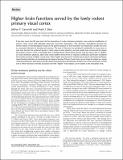| dc.contributor.author | Gavornik, Jeffrey | |
| dc.contributor.author | Bear, Mark | |
| dc.date.accessioned | 2017-11-01T17:17:20Z | |
| dc.date.available | 2017-11-01T17:17:20Z | |
| dc.date.issued | 2014-09 | |
| dc.date.submitted | 2014-06 | |
| dc.identifier.issn | 1549-5485 | |
| dc.identifier.issn | 1072-0502 | |
| dc.identifier.uri | http://hdl.handle.net/1721.1/112111 | |
| dc.description.abstract | It has been more than 50 years since the first description of ocular dominance plasticity-the profound modification of primary visual cortex (V1) following temporary monocular deprivation. This discovery immediately attracted the intense interest of neurobiologists focused on the general question of how experience and deprivation modify the brain as a potential substrate for learning and memory. The pace of discovery has quickened considerably in recent years as mice have become the preferred species to study visual cortical plasticity, and new studies have overturned the dogma that primary sensory cortex is immutable after a developmental critical period. Recent work has shown that, in addition to ocular dominance plasticity, adult visual cortex exhibits several forms of response modification previously considered the exclusive province of higher cortical areas. These "higher brain functions" include neural reports of stimulus familiarity, reward-timing prediction, and spatiotemporal sequence learning. Primary visual cortex can no longer be viewed as a simple visual feature detector with static properties determined during early development. Rodent V1 is a rich and dynamic cortical area in which functions normally associated only with "higher" brain regions can be studied at the mechanistic level. | en_US |
| dc.description.sponsorship | National Eye Institute (Grant RO1 EY023037) | en_US |
| dc.description.sponsorship | National Institute of Mental Health (U.S.) (Grant K99 MH09965) | en_US |
| dc.publisher | Cold Spring Harbor Laboratory | en_US |
| dc.relation.isversionof | http://dx.doi.org/10.1101/LM.034355.114 | en_US |
| dc.rights | Creative Commons Attribution-NonCommercial 4.0 International | en_US |
| dc.rights.uri | http://creativecommons.org/licenses/by-nc/4.0/ | en_US |
| dc.source | Cold Spring Harbor Laboratory Press | en_US |
| dc.title | Higher brain functions served by the lowly rodent primary visual cortex | en_US |
| dc.type | Article | en_US |
| dc.identifier.citation | Gavornik, Jeffrey P. and Bear, Mark F. “Higher Brain Functions Served by the Lowly Rodent Primary Visual Cortex.” Learning & Memory 21, 10 (September 2014): 527–533 © 2014 Gavornik and Bear | en_US |
| dc.contributor.department | Massachusetts Institute of Technology. Department of Brain and Cognitive Sciences | en_US |
| dc.contributor.department | Picower Institute for Learning and Memory | en_US |
| dc.contributor.mitauthor | Gavornik, Jeffrey | |
| dc.contributor.mitauthor | Bear, Mark | |
| dc.relation.journal | Learning & Memory | en_US |
| dc.eprint.version | Final published version | en_US |
| dc.type.uri | http://purl.org/eprint/type/JournalArticle | en_US |
| eprint.status | http://purl.org/eprint/status/PeerReviewed | en_US |
| dc.date.updated | 2017-10-26T12:59:04Z | |
| dspace.orderedauthors | Gavornik, Jeffrey P.; Bear, Mark F. | en_US |
| dspace.embargo.terms | N | en_US |
| dc.identifier.orcid | https://orcid.org/0000-0001-8420-8973 | |
| mit.license | PUBLISHER_CC | en_US |
| mit.metadata.status | Complete | |
